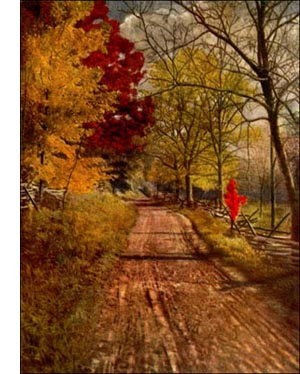Red Oak Tree
 Red Oak (Quercus rubra, Linn.)-A large, stately tree, 50 to 150 feet high, with columnar trunk and round, symmetrical head of stout, spreading branches. Bark greyish brown with red tinge, with wide furrows between ridges; twigs reddish. Wood redbrown, with darker sap wood, coarse grained, with well-marked annual rings and medullary rays; heavy, hard, strong. Buds reddish, pointed, 1/4 inch long. Leaves alternate, 7 to 9-lobed, 5 to 9 inches long, 4 to 6 inches wide; lobes and sinuses both triangular in form; second pair from apex always largest; lobes irregularly toothed and bristly pointed; leaves variable in size and form; lining paler green, smooth at maturity; autumn colour deep red. Flowers, May, with half-grown leaves; staminate catkins, yellow, hairy, 4 to 5 inches long; pistillate, on short 2 to 3-flowered stems; stigmas, long, bright green. Acorns ripe second autumn; large, 3/4 to 1 1/4 inches long; broad at base, in closescaled, shallow saucer; kernel white, extremely bitter. Preferred habitat, rich, well-drained stream borders. Distribution; Nova Scotia to Minnesota; south to Georgia, Tennessee and Kansas. Uses: A handsome, quick-growing shade and ornamental tree, easily transplanted and free from insect pests. Wood used in cooperage, cheap furniture, in construction and finish of buildings and for fuel. It is inferior to white oak. Bark rich in tannic acid, used in tanning leather.
Red Oak (Quercus rubra, Linn.)-A large, stately tree, 50 to 150 feet high, with columnar trunk and round, symmetrical head of stout, spreading branches. Bark greyish brown with red tinge, with wide furrows between ridges; twigs reddish. Wood redbrown, with darker sap wood, coarse grained, with well-marked annual rings and medullary rays; heavy, hard, strong. Buds reddish, pointed, 1/4 inch long. Leaves alternate, 7 to 9-lobed, 5 to 9 inches long, 4 to 6 inches wide; lobes and sinuses both triangular in form; second pair from apex always largest; lobes irregularly toothed and bristly pointed; leaves variable in size and form; lining paler green, smooth at maturity; autumn colour deep red. Flowers, May, with half-grown leaves; staminate catkins, yellow, hairy, 4 to 5 inches long; pistillate, on short 2 to 3-flowered stems; stigmas, long, bright green. Acorns ripe second autumn; large, 3/4 to 1 1/4 inches long; broad at base, in closescaled, shallow saucer; kernel white, extremely bitter. Preferred habitat, rich, well-drained stream borders. Distribution; Nova Scotia to Minnesota; south to Georgia, Tennessee and Kansas. Uses: A handsome, quick-growing shade and ornamental tree, easily transplanted and free from insect pests. Wood used in cooperage, cheap furniture, in construction and finish of buildings and for fuel. It is inferior to white oak. Bark rich in tannic acid, used in tanning leather.There is no American oak more highly prized in Europe than the common red oak. It has been cultivated there for two centuries, and splendid specimens are pointed out with pride, especially in Belgium, Germany and England. It is the "champion oak" which flames in English parks when the foliage of native species falls without a hint of the brilliant colouring which we always expect in autumn woods.
The red oak is so common in our Eastern forests that we have not realised its worthiness as a street and ornamental tree. Surely it is a stately tree in the forest, and as noble and benignant a figure as the white oak where it has ample room to develop its round dome. It grows faster than any other native oak and in a greater variety of soils. It can be transplanted, even when 15 feet high, from the woods to a lawn, and not notice the change. After it becomes established a growth of a foot or more in height may be expected yearly, and an increase in diameter of an inch of wood in five years.
The shining leaves of red oak, though they are variable in form, are always cut oval and into triangular lobes which point forward, rather than outward. The sinuses are angled or rounded, but are not so broad as those of the black oak. These leaves are leathery and smooth, those of black oak are rougher. The bloom of red oak is more luxuriant than that of other oaks. The tree is fairly draped with its long yellow catkins, and the red stigmas shine out against the silvery pink of opening leaves.
The acorns of the red oak are unique. They are large, in pairs, on very short stalks, and the nut sits in a broad, shallow saucer covered with small, close-fitting scales. The acorn crop is two years in ripening, but the tree is so vigorous that there are usually nuts, or at least saucers, in evidence to identify the tree, if the leaves do not determine it with certainty. The under bark is red, that of black oak is orange-yellow. This is another way to tell the two species apart at any time of year by the aid of a pocket knife.